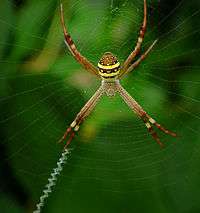Argiope keyserlingi
| Argiope keyserlingi | |
|---|---|
 | |
| A. keyserlingi from Queensland | |
| Scientific classification | |
| Kingdom: | Animalia |
| Phylum: | Arthropoda |
| Class: | Arachnida |
| Order: | Araneae |
| Family: | Araneidae |
| Genus: | Argiope |
| Species: | A. keyserlingi |
| Binomial name | |
| Argiope keyserlingi Karsch, 1878 | |
Argiope keyserlingi is a common species of orb-web spider found on the east coast of Australia, from central New South Wales to southern Queensland. It is very similar in appearance to the closely related north Queensland species, Argiope aetherea. A. keyserlingi is commonly found in large populations in suburban parks and gardens, particularly amongst the leaves of Lomandra longifolia. Like many species of orb-web spider, A. keyserlingi shows considerable sexual size dimorphism, with the females being many times larger than the males. Mature females can be seen during the summer months and it is not uncommon to see multiple males on the web of one female.
This spider is commonly known as the St Andrew's Cross spider, due to the construction of bands of silk forming the arms of an X-shaped cross, similar to the one upon which St. Andrew is traditionally said to have been crucified. Termed web decorations or stabilimenta, these bands are thought to increase prey capture in this species, however, in other species they have been found to protect the spider against predators.
A. keyserlingi is an important model species in studies of spider ecology and behaviour. Using this species scientists have investigated sperm competition, sexual size dimorphism, cryptic female choice, the role of pheromones in mating behaviour and the function and evolution of web decorations.
Its main predators in Sydney are mantids and birds.[1]
Name
The Latin species name was chosen to honor arachnologist Eugen von Keyserling. The spider is also commonly called the crucifix spider.
Different views & aspects
-

St Andrew's Cross spider displaying distinctive cross.
-

Dorsal and ventral view of the same spider.
Footnotes
- ↑ Blamires et al. 2007
References
- Blamires, Sean J.; Hochuli, Dieter F. & Thompson, Michael B. (2007): Does decoration building influence antipredator responses in an orb-web spider (Argiope keyserlingi) in its natural habitat? Australian Journal of Zoology 55: 1-7. doi:10.1071/ZO06098 — PDF
- Platnick, Norman I. (2008): The world spider catalog, version 8.5. American Museum of Natural History.
External links
| Wikimedia Commons has media related to Argiope keyserlingi. |
| Wikispecies has information related to: Argiope keyserlingi |